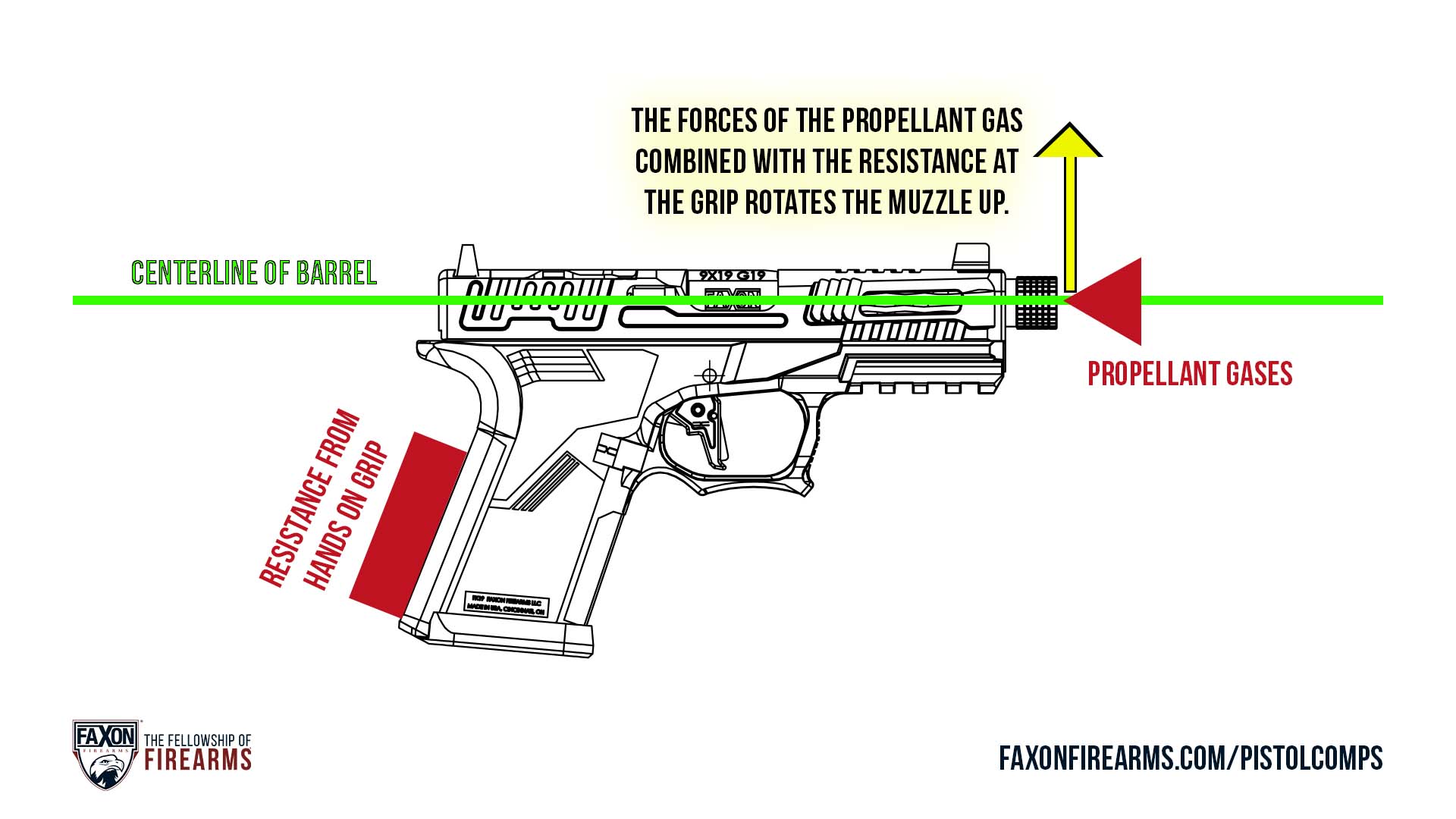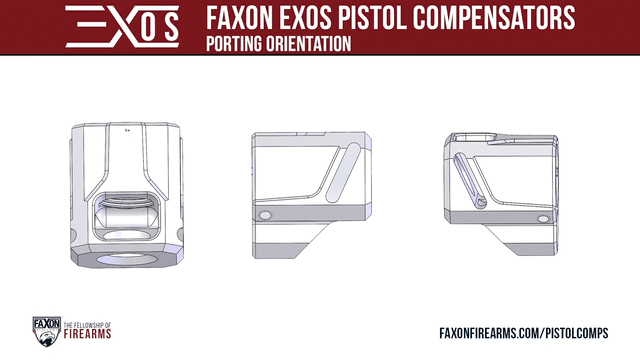Posted by Faxon Firearms Staff on Sep 21st 2021
How Do Pistol Comps Work?
A Pistol Compensator (or Pistol Comp) is a device attached to the end of a threaded pistol barrel to help reduce Muzzle Flip, and felt recoil when firing a handgun.
Muzzle Flip (also known as Muzzle Rise, or Muzzle Climb) is the tendency of the muzzle-end (or front end) of the barrel to rise after firing.
Muzzle flip occurs on nearly all handguns due to their center of mass.
On nearly all handguns, the bore axis (the longitudinal centerline of the barrel) is above the center of mass of the firearm while the grip is below the center of mass.
When a handgun is fired, the bullet and the escaping propellant gases create a reactional recoil. This recoil travels backward along the bore axis. Since the shooter's hands are on the grip of the handgun, below the bore axis and center of mass, it creates a rotational couple. In other words, the force of the recoil combined with the countering pressure of the shooter's grip creates torque.

Imagine shooting a handgun with poor, loose grip technique. The handgun would rotate up from the muzzle, and backward toward you... much like you see in any variety of "handgun fail" videos.


Even if you have a fantastic grip technique, the physics of a handgun firing still forces you to overcome muzzle flip and felt recoil. Both are variables in your overall accuracy.
Pistol Comps are designed to reduce these variables by vectoring propellant gas upwards to create reactional downward torque on the muzzle.
On models 513, 514, and 515 of the Faxon EXOS pistol compensators, there are 3 ports used to create this reactional downward torque.

The first is located on top of the comp. This port uses the upward path of escaping gasses to push down the muzzle. Further, the chamber at the muzzle end of the EXOS comp is angled, tapering up, which uses the escaping gas to push the muzzle forward.
This is replicated on the 2 side ports of the EXOS compensators. Instead of straight, vertical ports on the sides which only push gas out (side-to-side), EXOS ports are angled forward which aids in reactional downward force. By angling the side ports you trade some of the forward push you usually get for more downward push, which can reduce the need for tuning the gun for reliable function.
During the development process of the EXOS pistol comps, the team at Faxon recorded the muzzle flip with a bare muzzle as the control measurement. Then, measurements were taken of competitor compensators and Faxon EXOS compensators.
Here are the findings.
- Handgun: Glock® 19, Gen 3
- Bare Muzzle Average: 21.1°
- Competitor Comp Average: 15.9° (24.6% Muzzle Flip Reduction compared to bare muzzle)
- EXOS-513 Average: 15.1° (28.43% Muzzle Flip Reduction compared to bare muzzle)
- Handgun: M&P® 9mm, Gen 1
- Bare Muzzle Average: 23.7°
- Competitor Comp Average: 19° (19.81% Muzzle Flip Reduction compared to bare muzzle)
- EXOS-514 Average: 18.1° (23.62% Muzzle Flip Reduction compared to bare muzzle)
- Handgun: SIG® P320 Full-Size
- Bare Muzzle Average: 24°
- Competitor Comp Average: 19.6° (18.33% Muzzle Flip Reduction compared to bare muzzle)
- EXOS-515 Average: 18.8° (21.66% Muzzle Flip Reduction compared to bare muzzle)
EXOS-523 & EXOS-533 Comps
- G43/43X: 27% Reduction in Muzzle Flip compared to bare muzzle
- G48: 33% Reduction in Muzzle Flip compared to bare muzzle
- G43/43X + G48: 13% Reduction in Muzzle Flip compared to competitor compensator average
Learn More about Faxon EXOS Pistol Compensators: FaxonFirearms.com/PistolComps



